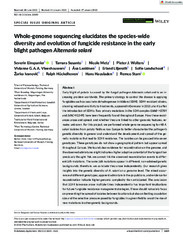Приказ основних података о документу
Whole-genome sequencing elucidates the species-wide diversity and evolution of fungicide resistance in the early blight pathogen Alternaria solani.
| dc.creator | Einspanier, Severin | |
| dc.creator | Susanto, Tamara | |
| dc.creator | Metz, Nicole | |
| dc.creator | Wolters, Pieter | |
| dc.creator | Vleeshouwers, Vivianne | |
| dc.creator | Lankinen, Åsa | |
| dc.creator | Liljeroth, Erland | |
| dc.creator | Landschoot, Sofie | |
| dc.creator | Ivanović, Žarko | |
| dc.creator | Huckelhoven, Ralph | |
| dc.creator | Hausladen, Hans | |
| dc.creator | Stam, Remco | |
| dc.date.accessioned | 2023-07-15T07:37:14Z | |
| dc.date.available | 2023-07-15T07:37:14Z | |
| dc.date.issued | 2022 | |
| dc.identifier.issn | 1752-4571 | |
| dc.identifier.uri | https://plantarum.izbis.bg.ac.rs/handle/123456789/745 | |
| dc.description.abstract | Early blight of potato is caused by the fungal pathogen Alternaria solani and is an increasing problem worldwide. The primary strategy to control the disease is applying fungicides such as succinate dehydrogenase inhibitors (SDHI). SDHI-resistant strains, showing reduced sensitivity to treatments, appeared in Germany in 2013, shortly after the introduction of SDHIs. Two primary mutations in the SDH complex (SdhB-H278Y and SdhC-H134R) have been frequently found throughout Europe. How these resistances arose and spread, and whether they are linked to other genomic features, remains unknown. For this project, we performed whole-genome sequencing for 48 A. solani isolates from potato fields across Europe to better characterize the pathogen's genetic diversity in general and understand the development and spread of the genetic mutations that lead to SDHI resistance. The isolates can be grouped into seven genotypes. These genotypes do not show a geographical pattern but appear spread throughout Europe. We found clear evidence for recombination on the genome, and the observed admixtures might indicate a higher adaptive potential of the fungus than previously thought. Yet, we cannot link the observed recombination events to different Sdh mutations. The same Sdh mutations appear in different, non-admixed genetic backgrounds; therefore, we conclude they arose independently. Our research gives insights into the genetic diversity of A. solani on a genome level. The mixed occurrence of different genotypes, apparent admixture in the populations, and evidence for recombination indicate higher genomic complexity than anticipated. The conclusion that SDHI tolerance arose multiple times independently has important implications for future fungicide resistance management strategies. These should not solely focus on preventing the spread of isolates between locations but also on limiting population size and the selective pressure posed by fungicides in a given field to avoid the rise of new mutations in other genetic backgrounds. | sr |
| dc.language.iso | en | sr |
| dc.publisher | Wiley | sr |
| dc.rights | openAccess | sr |
| dc.rights.uri | https://creativecommons.org/licenses/by/4.0/ | |
| dc.source | Evolutionary Applications | sr |
| dc.subject | agriculture | sr |
| dc.subject | Alternaria solani | sr |
| dc.subject | fungicide resistance | sr |
| dc.subject | plant pathology | sr |
| dc.subject | population genetics –empirical | sr |
| dc.subject | potato | sr |
| dc.title | Whole-genome sequencing elucidates the species-wide diversity and evolution of fungicide resistance in the early blight pathogen Alternaria solani. | sr |
| dc.type | article | sr |
| dc.rights.license | BY | sr |
| dc.citation.epage | 1620 | |
| dc.citation.issue | 10 | |
| dc.citation.rank | M21 | |
| dc.citation.spage | 1605 | |
| dc.citation.volume | 15 | |
| dc.type.version | publishedVersion | sr |
| dc.identifier.doi | 10.1111/eva.13350 | |
| dc.identifier.fulltext | http://plantarum.izbis.bg.ac.rs/bitstream/id/2963/bitstream_2963.pdf | |
| dc.identifier.scopus | 2-s2.0-85125759993 | |
| dc.identifier.wos | 000758930600001 |


